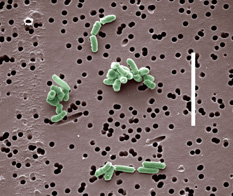Taxonomic Information
Domain: Bacteria
The Domain Bacteria are described by the following
characteristics:
1) Prokaryotic cells, so they lack a nucleus and membrane-bound
organelles.
2) Their genetic information is not found within the nucleus.
3) The cell walls contain
peptidoglycan.
To view the organism Streptomyces griseus, which is
also from this domain, please click
here.
Kingdom: Bacteria
This kingdom is characterized by the same descriptions as the
Domain above.
Phylum: Actinobacteria
The Phylum Actinobacteria are one of the more dominant phyla
within the Bacteria. They are classified as being Gram-positive
bacteria with large contents of guanine and cytosine.

Brevibacterium linens is a gram-positive organism. This means that it has a cell wall made of a peptidoglycan layer found outside of its plasma membrane. When gram stained, gram-positive bacteria are purple in color; however, gram-negative bacteria which have their peptidoglycan layer in between an outer membrane and the plasma membrane, are pink in color.
Class: Actinobacteria
The Class Actinobacteria is characterized by the same
descriptions as the Phylum above.
Order: Actinomycetales
The word "Actinomycetales" means "filamentous or rod-shaped
bacteria". This is exactly why Brevibacterium linens falls under
this order, because they are a rod-shaped bacteria. Also, all
members of this order are gram-positive. They can undergo either
aerobic or facultative anaerobic growth.
To view another organism that falls under this order, please click
here.
Family: Brevibacteriaceae
Genus: Brevibacterium
This genus is a combination of coryneform
bacteria that are used to create vitamins, amino acids for chemical
production, and are primarily used in cheese making. These bacteria
also had a rod-coccus shape while they were developing. After they
grow older, they turn into their normal rod-shaped structure. They
are sessile (non-motile) individuals,
chemoorganotrophic, and halotolerant (greater than or equal to
6.5% Sodium Chloride).
Species: Brevibacterium linens
This is the scientific name for this organism. Its common
name is "Lactic Acid Bacteria"
The phylogenetic tree above is based off of molecular DNA. The gene sequence that was used to organize this phylogeny are the neighbour-joining of 16S rRNA genes. The organism Brevibacterium linens is the second from the top, and it is most closely related to Breibacterium iodinum. The organisms B. otitidis and B. lutescens are the organisms furthest related from B. linens. Furthermore, all of these organisms evolved from a now extinct ancestor.

This phylogenetic tree is based off of molecular RNA data. The purpose of this tree is to show the separation of the three domains and some of the types of organisms that fall within these domains. Brevibacterium linens falls under the "Gram positives" category beneath the Bacteria domain.





